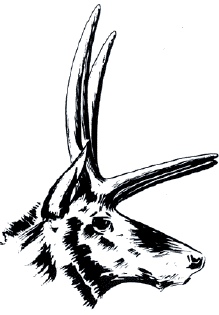|
The Exciting Unknown
What kind of creature had two horns, or prongs, or each side of its head?
One of the boys ran to his knapsack and brought back a pocket edition of a book
on American mammals. He soon found a picture of a modern American prongbuck, or
pronghorn
(an antilocaprid), and
showed it to the others. But the modern animal’s horns were forked. There were
no forks on the fossil horns, nor were there rough places indicating that forks
might have been there. One of the boys summed up their opinions. “We don’t
know what it was, but it must have been something like an antelope or maybe a
four-pronged or four-horned deer; that means it must have been a plant-eater a
herbivore.”
|

|
Stirton's reconstruction of Tetrameryx
irvingtonensis Stirton. The modern progbuck, or pronghorn of
the American west, may be descended from T. irvingtonebsus. |
During the afternoon the group continued to speculate about their new
find as they searched for and found other fossilized remains: horse teeth and
the teeth and vertebrae of a large camel. These were recognized when found,
because others like them have been discovered at Locality V3604 in the past and
had been identified by paleontologists at the University of California.
Furthermore, the boys had spent many hours looking at drawings of all kinds of
fossil bones in specific journals. They also referred often to their collection
of old books anatomy, which contained pictures of teeth and bones of many kinds
of animals.
Each boy was sure that by the next Saturday he would know what those four
horns and the skull represented. The director took the fossil to the University
for Identification, as had been done before when something new was found. On
Monday several paleontologists inspected the fossil and were pleased to find
that it was part of a four-pronged antilocaprid from Irvington, previously named
by Dr. R.A. Stirton, then professor of paleontology at the university.
Why were the scientists excited about this particular fossil? It was
complete enough to confirm Dr. Stirton’s drawing, which showed how he thought
the head of the animal looked when the animal was alive. A few years before,
three fragmentary horns-cores and two-thirds of a left metatarsal (foot bone)
had been found at Locality V3604 and sent to Dr. Sirton’s at the university.
Although these four bones were his total evidence, he proposed that they
belonged to a hitherto undiscovered species of antilocaprids, which he named Tetrameryx
irvingtonensis Stirton. How could he reach this conclusion? He arrived at it
by comparing the unknown fossils to known specimens. Although the metatarsal was
fragmentary, it was complete enough to suggest the type of animal to which it
belonged. It was certainly too large to be mouse and too small to be mammoth!
When Dr. Stirton compared the metatarsal and horn-cores with parts from
unknown specimens, he discovered that the unknowns were similar to, but slightly
different from, any of the knowns. The modern prongbuck now living in western
North America was among the known specimens whose skeletal parts were belonging
to a great variety of fossil antilocaprids that had previously been identified.
It has been emphasized that imagination as well as knowledge is necessary
in the reconstruction of paleoecosystems. It is no wonder, then, that the nearly
complete skull and horns of T. irvingtonensis delighted the scientists at
the university. Imagination, based on knowledge, had reconstructed the
appearance of the head of the animal.
Since that discovery by the amateur paleontologists, many partial skulls
of T. irvingtonensis have been discovered at Localtiy V3604, as well as vertebrae, skull with teeth, and lower jaws
with teeth. But to date the first skull is still the most complete by far.
The finding of so many “samples” of T. irvingtonensis led to
an odd discovery: No skull with horn-cores contained teeth. Nevertheless, Dr.
Stirton concluded that horn-cores and teeth belonged to the same animal species.
What was his reasoning?
|